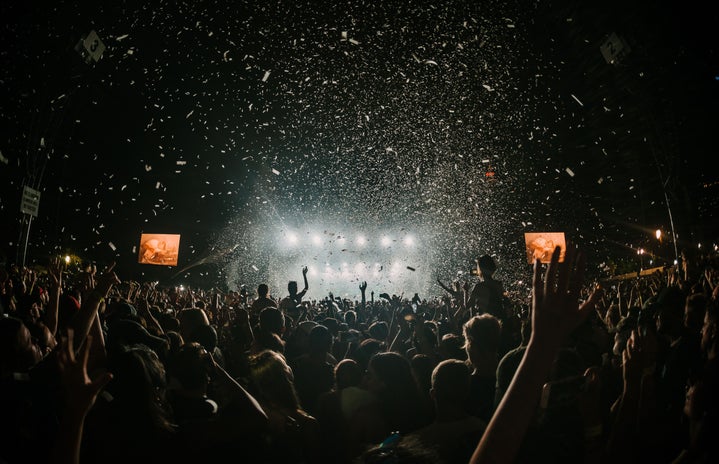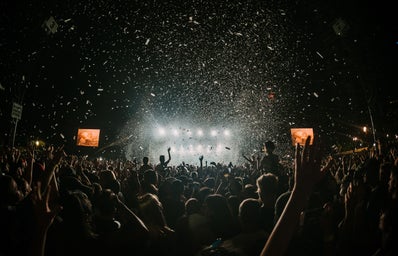This article contains spoilers for the show and book “Daisy Jones and The Six”
“Daisy Jones and The Six” is a new Amazon Prime show that depicts the euphoric rise and dramatic fall of a fictional 1970s rock band. The show is adapted from a book of the same name written by Taylor Jenkins-Reid and released in 2019. “Daisy Jones” is a whirlwind of music industry politics, feuding friends, and an amazing ‘70s style.
Daisy Jones (Riley Keough) is an enigmatic free spirit who spends her adolescence exploring the rock music scene in Los Angeles before realizing what she really wants is to be a songwriter. She is a feminist who knows she deserves better than being a man’s muse: she wants the spotlight herself.
Across the country, in Pittsburgh, Billy Dunne (Sam Claflin) is becoming a rock star in his own right when he joins his brother’s garage band and sets his sights on LA. He falls in love with Camila (Camila Morrone), recruits Karen (Suki Waterhouse), a talented musician stuck in a dead end small town band, and they set off for LA.
The three-episode premiere that just came out traces and brings together the two separate storylines. Daisy starts writing songs and quickly learns to value her own self worth while men in the music industry take credit for her work and disrespect her. Billy and the rest of the band start performing and making industry connections, but as their star power rises, Billy’s rock star life hurts everyone around him and himself. He cheats on his pregnant wife, Camila, with groupies, and slips into addiction. The third episode ends with Billy and Daisy, who will go on to be tempestuous rivals and maybe more than that, meeting for the first time. Revered producer Teddy Price has been working with both, and sees the potential for a partnership, but the two clash almost as soon as they step foot in the studio. Although the third episode ends with them collaborating on their soon-to-be famous song “Look At Us Now” (Honeycomb), fans of the book are left on the edge of their seats anticipating the rivalry to come. What both readers of the book and fans of the many, many TikTok edits know is that the show is gearing up for drama, with Daisy and Billy growing closer as they realize they share similar artistic dreams, and Camila left always unsure of the true nature of their relationship.
As I wonder how the show will execute the book’s many twists and turns, I reflect on the way popular media often appears too sanitized, too perfect. Big-budget movies, such as additions to the Marvel Cinematic Universe, are expected to hit every beat in a tried-and-true formula for success, balancing comedy, action, heart, and visual effects with the end goal being money, rather than artistic value or audience appreciation. The TV shows that get renewed generally follow the same tropes and often don’t color too far outside the lines. The blandness of popular media can even be seen in our technology, not just our plotlines, affecting things like camera work and coloring. One blogger, Haley Nahman, writes in an article about Netflix’s visual blandness that most of what we consume is “an endless stream of glossy vehicles that are easy to watch and easier to forget.” They look similar and their plots and pacing are similar. Ultimately it is hard to create subversive, counter-cultural art in a late-stage capitalist world that is fixated on profit at all costs. “Daisy Jones and The Six” is not exempt from this problem.
What fans loved about the book, and what earlier generations loved about the band that inspired the book, Fleetwood Mac, was the messiness, the imperfections. The book doesn’t fully demonize any of the characters in what could have easily become a petty love triangle. Camila is not weak and powerless to stop Daisy and Billy’s burgeoning love connection. Rather, she sees both of them for exactly who they are and makes it clear that she will not be made a helpless housewife. Daisy, who could easily have been written as a spoiled princess or a homewrecker, is respected for her grit and talent and never blamed for the actions of the men around her. Billy is expected to shoulder the blame for his infidelity, yet he is not completely a villain either, as his relationships with his father, brother, Camila, and newborn child all paint a picture of a man who is flawed but trying to be good, who makes mistakes but also loves his family deeply. Writing these nuances is a feminist act on the part of Jenkins-Reid in a world that often exonerates men and puts their actions on the shoulders of unwilling women. She refuses to reduce the three leads to stereotypes, instead creating fully rounded characters who must reckon with the impacts of stardom, addiction, familial bonds, and the patriarchy. The characters are messy and imperfect, and the story is too–the book is a whirlwind of plot twists, secret love affairs, and wild adventures and it feels natural and exciting, never too polished.
The show makes it clear some of these nuances will be lost in order to create a glossy, impressive vehicle for Amazon Prime to show off their filmmaking abilities. Trailers and promo content show the burgeoning love triangle as much more traditional than in the book, with much of Camila’s agency stripped away. The other band members will not be given the same storylines they had in the book–even in this article I haven’t named these other band members because so far they have had a minimal impact on the story.
Additionally, the marketing reveals the way media now is engineered for max profit, every step of the promotion carefully engineered. Alongside the release of the show, Free People will release a “Daisy Jones and The Six” themed clothing line. Popular artists like Phoebe Bridgers and Marcus Mumford worked to adapt song lyrics from the book into a full length album, released on March 2. Fans can buy $30 vinyls of the album at Urban Outfitters or on Amazon. Barnes & Noble now features a new edition of the book with an updated cover featuring a still from the show and a sticker stating that the book is now an original Amazon Prime show. It’s hard to feel fully immersed in the media we are watching when we are aware that it has been created to earn money rather than satisfy fans. While this has always been true–the entertainment industry needs to make money in order to survive–the marketing we are fed now is so blatant and the content itself often so shallow that it feels less fun to engage.
Still, for a show that is just another cog in a corporate machine, “Daisy Jones and The Six” is a lot of fun. The pacing of the first three episodes is smart, building up to the meeting between Daisy and Billy and leaving off with an amazing song. Certain iconic lines from the book have been left untouched, something that the book lovers will appreciate, and the songs have been brought to life in ways that are exciting both sonically and lyrically. The costuming is stunning, and it’s a thrill to watch immensely talented actors absolutely nail their parts.
It doesn’t have the same messiness as the rock industry scandals of the 60s and 70s or the raw emotions of the book, but it’s exciting to watch and beautifully composed. I eagerly await the next installment.
If you would like to write for Her Campus Mount Holyoke, or if you have any questions or comments for us, please email hc.mtholyoke@hercampus.com.

